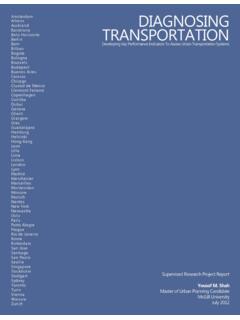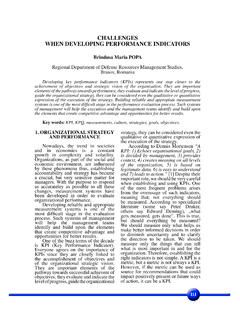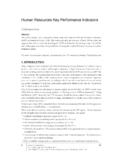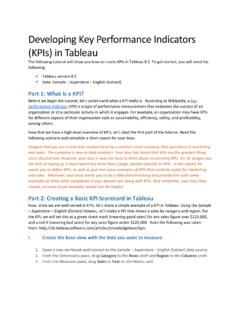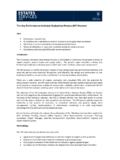Transcription of Diagnosing Transportation - tram.mcgill.ca
1 Diagnosing Transportation developing Key performance Indicators to Assess Urban Transportation Systems Yousaf Shah, Kevin Manaugh, Madhav Badami, and Ahmed El-Geneidy Rapid urbanization is putting pressure on Transportation agencies sizes and gross domestic products (GDPs). The intent of such a to respond to an increasing demand for Transportation networks with comparison is to benchmark the performance of a city's transporta- greater effectiveness and efficiency. In response, policy makers, faced tion system according to that of peer cities with relatively similar with limited budgets and time constraints, are looking for tools and networks. Such an approach helps designate key problems that account processes to identify priority problems in a timely and cost-effective for context as well as overcome gaps due to the unavailability of manner.
2 Rapid assessments can be performed with diagnostic tools that benchmarking data. identify cities' Transportation problems within the global context. Using Three questions are addressed to develop the diagnosis: (a) What a series of performance indicators that are based on a review of research kind of performance indicators must be measured to identify priority and practice from around the world, this paper assesses cities' trans- problems in urban Transportation ? (b) What kind of readily avail- portation networks. The performance indicators rank cities according to able data are appropriate for measurement? (c) How can results be an overall score as well as categories of Transportation performance . compared to better account for context? Such an approach allows planners to identify priority problems in the The final output of this article is an initial diagnosis and rank- Transportation network to design targeted solutions.
3 The final results ing of the transport systems of cities around the world as well as a benchmark the performance of Transportation systems according to suggested set of measures that can be used to assess Transportation the performance of the systems in peer cities with relatively similar performance according to the common goals and objectives of trans- sizes. Such a process assists with the benchmarking of performance and portation agencies. Alignment of indicators to a broad criterion of accounts for context so that appropriate best practices can be shared goals assists with the harmonization of performance measurements between cities around the world. between local, national, and international agencies. Development and planning agencies can use the final set of core performance indicators to evaluate the current state of Transportation in cities.
4 Transportation planning has multiple economic, environmental, and This paper is organized as follows: first, a review of the research social goals. Cities often see investment in urban Transportation on Transportation performance indicators is presented to justify the infrastructure to be a means of providing opportunities for increas- selection of those indicators. Second, Transportation plans, policies, ing competitive economic advantage (1 3). In response, the need for and research are analyzed to identify common urban Transportation tools that can help planning professionals quickly identify priority goals and the indicators used to measure progress toward the achieve- problems (4) and efficiently allocate infrastructure and prioritize ment of these goals. Third, a methodology section frames how the investment (5) is growing. Additionally, cities are increasingly viewed analysis is undertaken and presented.
5 Fourth, the sources of the data as logistics centers in a globalized marketplace; their focus on com- are identified and the data used for this study are validated. Finally, petition and rankings means that their performance relative to that of a diagnosis is performed according to the composite indicators with their peers is more important than their absolute performance (1, 6). the available data, results are presented, and recommendations for In any case, before comprehensive solutions to address Transportation further research are made. problems can be identified, a diagnostic study needs to be performed to identify cities' individual problems within the global context. This paper proposes a diagnostic tool to assist with the formation Literature of an initial review of the state of a city's Transportation network. The tool uses a series of performance indicators that are based on research As a result of globalization and the role of Transportation in the and practice from around the world to assess different cities' trans- economy, two major themes govern 21st century Transportation portation networks.
6 The results are ranked to provide a comparison planning: sustainable development and global competitiveness (1). of Transportation systems between cities with similar population Measures and scores of competitiveness provide rankings that can serve as benchmarks for policy makers and other interested parties School of Urban Planning, McGill University, Suite 400, 815 Sherbrooke Street to judge the success or relative position of their nations or cities West, Montreal, Quebec H3A 2K6, Canada. Corresponding author: A. El-Geneidy, within a global context (6). Sustainable development is becoming an overarching concept behind urban Transportation planning as a response to rising rates of motorization and the need to ensure public Transportation Research Record: Journal of the Transportation Research Board, No. 2357, Transportation Research Board of the National Academies, Washington, health while minimizing environmental risks (1).
7 , 2013, pp. 1 12. In North America, although various agencies have incorporated DOI: sustainable development into their visioning and planning exercises, 1. 2 Transportation Research Record 2357. no comprehensive definition of urban transport sustainability has been learned on the use of performance measures from Transportation identified. However, most plans propose an operational definition that research, the following section frames a methodology for selection rests on attributes of system efficiency; effectiveness; and impacts on of the indicators to be used for this study. the economy, environment, and society (7). Efficiency measures the operational performance of the system, and effectiveness measures a Transportation system's progress toward achievement of its policy Methodology goals (8). Because effectiveness aims to measure progress toward achievement of goals and objectives, potential indicators should To select the indicators for this study, a qualitative analysis of the be identified and selected after goals and objectives have been content of Transportation plans and policy documents was performed formulated (8).
8 To identify the indicators most commonly used around the world. The indicators from transport policy documents can then be used to The Lincoln Institute of Land Policy identifies three principles for the inform how urban Transportation is actually measured and evaluated in selection of indicators (16): different cities around the world. Policy-based indicator systems tend to view a sector holistically and intend to foster dialogue between Validity, which means that the indicator must have a direct link the different stakeholders in urban development (5). Use of a holistic to a relevant policy intervention;. approach is important to understand and respond to externalities. Availability, which means that the indicator must be quantifiable Interventions may have unintended consequences. It is therefore with easily accessible data; and important to attempt to identify all potential future effects (8).
9 Reliability, which means that the data must have been gathered A number of studies and projects that assess Transportation indica- by a public or a governmental authority. tors for appropriate use and implementation have been performed. At the corridor level, Tiwari and Jain, analyzing a bus rapid transit This list should be considered the minimum requirement for a route in New Delhi, India, illustrate that traditional indicators favor the performance indicator . Other important aspects include whether free movement of vehicles without taking into account capacities and indicators can be operationalized and scaled properly and are designed road usage by other modes (9). From an infrastructure investment per- to measure accurately that which should be measured. In addition, spective, Li and Wachs compared light rail transit and bus rapid transit as a whole, a set of indicators must adequately measure a wide range of routes in Los Angeles, California, and San Francisco, California, to benefits and impacts, which include the environmental, economic, show that the choice of indicators can have starkly variable results and efficiency, and social justice impacts of urban transport systems.
10 Can affect the identification of key problems (10). Many of these concerns, however, are out of the scope of this paper On a global level, Westfall and de Villa, in cooperation with the and require further investigation. Asian Development Bank, prepared a city performance system that The first step is to review the goals of the Transportation plans. After measures urban development and compares results across 18 cities goals are identified, they are placed into a set of categories to relate in Asia (5). The Economist Intelligence Unit, in partnership with directly goals to indicators. Indicators from three sets of documents Siemens AG, developed the green city index, an indicators-based are then identified: Transportation plans, Transportation studies by evaluation project that looked at the environmental sustainability international agencies and nongovernmental organizations, and performance of cities around the world (11).
